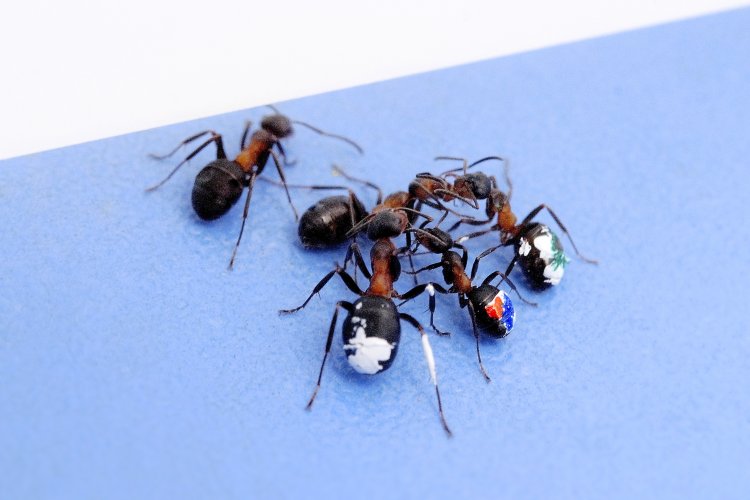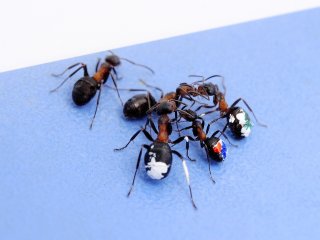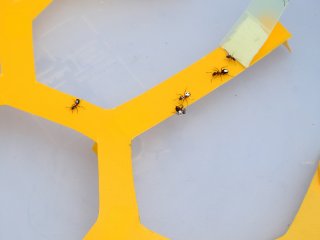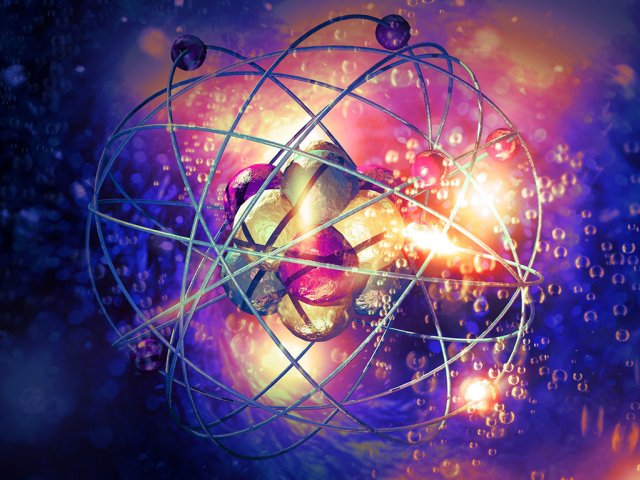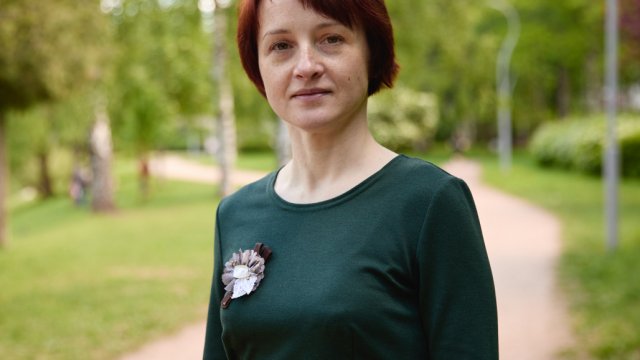Pigeons distinguish Monet from Picasso, ants can count, and crows can understand symbols. And what else is known about the cognitive abilities of animals? What are their unique abilities, and what are ours? Zhanna Reznikova, a well-known ethologist, Doctor of Biological Sciences, head of the Laboratory of Behavioral Ecology of Communities of ISEA SB RAS, Professor of NSU, spoke about the geniuses of the animal world and answered questions about the intelligence of animals and humans.
─ Charles Darwin said that the difference in the mental abilities of humans and higher animals is in quantity, not quality. Today, when we have accumulated a lot of knowledge in the field of biology, including through experiments, does this thesis remain relevant?
─ Darwin undoubtedly revolutionized the approach to the concepts of animal intelligence and their cognitive abilities. Basically, this thesis remains true. But science is developing quite rapidly, especially in recent decades, and now we know a lot more about it.
I am currently working on a book for Cambridge University, which is called Animal Intelligence: From Individual to Social Cognition. And, by the way, I also begin it with Darwin’s words: about the continuity of the cognitive abilities of humans and animals. Darwin wrote that the higher mental functions of man are a product of the evolution of the psyche of animals – their elementary thinking.
This book, as well as my scientific activity in general, represents such a field of science as cognitive ethology – the science of cognitive abilities of animals. Over the past 15-20 years, fundamentally new fields of science have emerged, such as optogenetics, which allows us not only to trace how excitation passes through the glowing neurons in the brain of an animal but even to some extent edit memory, intervene in these processes. This new science was born about 15 years ago. This example helps to imagine what a revolution is currently taking place in the field of cognitive ethology! And returning to your question: is there still a quantitative or qualitative difference in the mental abilities of humans and higher animals? Perhaps in the last decade, researchers around the world have concluded that one of our tasks is to find a qualitative difference as well. And, by the way, this difference is not always in our favor.
─ Do you mean those outstanding abilities of some animals that we do not possess?
─ Yes. In the book I mentioned, I present my new idea: about the species genius of animals. In particular, I want to show those intellectual achievements that exceed the human abilities that animals possess within rather narrow areas. For example, rats are much better at navigating the maze than we are. There has not yet been invented such a maze that a rat could not pass. If we compete with these animals in the passage of the maze, for example, a rat will pass with its paws, and we with a pencil, then the rat will win. None of the animals knows how to pass mazes better than rats, because, in fact, this is their habitat: they live in mazes.
As for chimpanzees, our closest relatives, it may seem strange, but they surpass us in the ability to memorize the number of faces, as well as quickly memorize and determine kinship relationships: who is who’s brother, nephew, and so on.
─ Some scientists believe that chimpanzees, unlike us, have a photographic memory. Is that the whole matter?
─ Here it’s not even a matter of the features of memory, but the features of perception within this segment. Just as rats have outstanding abilities in orientation and memorization of a topographic map, chimpanzees can memorize faces faster and better, as well as effectively determine their kinship relationships.
There are many “geniuses” among animals. New Caledonian crows are considered geniuses of tools. Pigeons have outstanding abilities for classification and 3D transformations. Pigeons solve well-known problems for the transformation of figures in space much faster than humans. Within these areas, pigeons have extremely developed cognitive abilities.
In 1995, three scientists from Keio University (Japan) received the Ig Nobel Prize in Psychology. In their experiment, scientists demonstrated that pigeons can effectively distinguish between painting styles. In the experiment, the birds were taught to distinguish Monet’s canvases from Picasso’s paintings. A few years later, the scientists published a series of papers in the authoritative journal Animal Cognition, and no one laughed at their research anymore.
Photo: fotocorn / 123RF
─ Is the species as a whole genius, or are there geniuses within one species and simple, unremarkable individuals?
─ This is a very interesting question, and the answer is both. The species as a whole may differ in some outstanding abilities, and there may also be individual geniuses. And here I want to return once again to the question of quantitative or qualitative differences between the intelligence of humans and other animal species:
When I talk about species genius, I conclude that human intelligence is universal, unlike the intelligence of other animals. And this is a qualitative difference. When we compare the abilities of different animals, we understand that each species is good in its narrow field, while human intelligence is universal: we can do this, that, and the fifth and tenth, as they say.
─ Do only higher animals have outstanding intellectual abilities or do insects have them too?
─ Insects also have their geniuses. Ants, for example, can remember and transmit abstract information and, moreover, capture patterns and use them to optimize their messages.
─ How so?
─ Ants of most species use very simple means of communication to attract relatives to food, among which the main role is played by the odorous trace. But highly social species, such as red wood ants, possess abstract, or symbolic, ways of transmitting information: one can transmit to another, for example, a message about the sequence and number of turns on the way to food.
─ Something like the bee dance?
─ Yes, but this communication is even more complicated than the well-known symbolic language of honeybee dances, with which they transmit information about the direction and distance to the food source to their relatives.
The figures of the dance are clearly distinguishable, they can be deciphered. Another case of deciphered elements of animal language is acoustic danger signals of African vervet monkeys, which correspond to different predators (leopard, snake, eagle). In general, the signals of animals, for example, dolphins or wolves, are very difficult to decipher.
As for ants, we do not yet know how they transmit messages to each other, since we are not trying to decipher the signals, but judge their “language” by the tasks they solve with it. Scout ants can transmit information to their relatives about the sequence of turns in the maze on the way to the bait. And if such a sequence contains a certain pattern, for example, “left-right, and so three times,” it is much easier to remember and pass it to us, people, than a random one. It turns out that ants can also catch patterns and use them to encode and optimize their messages. At the same time, the use of an odorous trace in our experiments is ruled out since we replace the maze with a new one after each scout passes. The main role in the transmission of signals in these species, apparently, is played by the rapid movements of the antennas. It can be said that among animals, honeybees and red forest ants are geniuses of communication.
Scout ants can count at least to twenty, encode information, add, and subtract, and also use a kind of calculus system resembling Roman numerals. Zhanna Reznikova and Boris Ryabko, an information theory specialist, came to such conclusions as a result of many years of research. In 2011, their article was published in Behaviour and caused considerable public interest. Photo: Nail Bikbaev
When we say that some individuals in a species have really outstanding abilities, we are talking about a few individuals. In highly social ant species, this is a group of scouts, about 1% of the ants from the entire anthill, numbering millions of individuals. But in our experiments with wild field mice, which can distinguish the number of figures in the pictures, it turned out that the species as a whole has outstanding intellectual abilities, and there are also some brilliant individuals. We are talking about our recent publication in Animal Cognition. Together with young colleagues from our laboratory, we discovered that ordinary field mice, which, however, have never been used in laboratories before, distinguish the number of geometric figures in pictures at the same level as monkeys do! For example, they distinguish eight out of nine, six out of seven. This is a very high level for animals. We assume that in medical experiments of the future, these field mice will be able to replace monkeys and help in the development of drugs for subtle mental disorders in humans, such as Alzheimer’s disease.
─ You say that people are distinguished by the universality of intelligence. Are there no animals that could also solve a very wide range of tasks? Maybe not as effective as we do it, but still…
─ Cognitive ethology has a lot of new data about our closest relatives. Chimpanzees, gorillas, bonobos, orangutans show high-level cognitive abilities in various fields: in quantitative assessments, in solving various tasks, and in mastering intermediary languages in which a person communicates with them.
Rats and pigeons are much more narrowly specialized in this regard. But people, by the way, also have their specifics. One of the specific features of our intelligence is the ability to quickly solve social problems.
Not only the development of language but also everything connected with social ties is the species genius of a person.
Experiments by a team of researchers from Cambridge and the Max Planck Institute have shown that chimpanzees and 2-4-year-old children solve physical problems (for example, concerning gravity, the location of objects in space, trajectory calculation, etc.) at about the same level. But in social tasks, including the ability to react to the gestures of a partner, to their facial expression, eye movement, etc., a person far surpasses our closest relatives of higher primates. A man can be said to be a genius monkey: in tasks that require accurate imitation of children, human children have no equal.
If we return to physical problems, now researchers continue to grope for the line that separates humans from animals when solving such problems. And it seems that our ideas about the ability of animals to detect cause and effect are a little exaggerated.
Recently, scientists, comparing higher primates, including humans, and corvids have come to interesting conclusions. It turns out that if we compare the abilities of a small child and a New Caledonian crow, then not all our hopes that crows understand cause-and-effect relationships well are justified. This issue requires further research.
─ We know that bees can solve some tasks with the same success as small children. Although it would seem that these are insects, and their brains are not large. The same goes for birds that also don’t have a cerebral cortex at all. So, what happens that neither the vaunted large brain size nor the presence of the cortex is essential for the development of intelligence?
─ Let’s start with the fact that everyone’s brain is arranged differently. In insects, the analog of the cerebral cortex is the so-called mushroom bodies – they contain associative centers. It is not so important where your associative centers are located, in the mushroom bodies or the cerebral cortex – the main thing is that they are there. In bees, mushroom bodies make up about 1/5 of the weight of their brain, indeed really small, the size of a millet grain (but we are no longer surprised by the size of microcomputers… and remember the giant computers of the 1970s?), and in ants it is as much as 50%, which, by the way, is comparable to a human: the cortex accounts for about half the weight of our brain.
Answering your question, the size of the brain is really not the most important indicator of the development of intelligence.
The so-called bee dance is one of the ways of their communication. For the first time, this phenomenon was studied by the Austrian ethologist Karl von Frisch. Photo: rawpixel / 123RF
Bees differ in their intelligence from many insects. You say that bees solve the same tasks as small children. That’s right. Bees, for example, solve so-called abstraction tasks. I took part in one of such experiments by the famous entomologist Georgy Alexandrovich Mazokhin-Porshnyakov as a student. He showed that bees can, for example, distinguish the shapes of a triangle, no matter how it is depicted: dotted, on a certain background or without, etc. Thus, bees have the concept of triangularity. But this is a fairly simple task. And the most difficult task (and it is already comparable to the level of a 5-6-year-old child) of those that bees solve is the recognition of chains that consist of sequences of different figures arranged either in pairs or randomly – the so-called pair and non-pair tasks. Even if not immediately, for the fiftieth time of changing the figures in the chains, the bees fully understood the condition of the task.
If simple abstraction tasks are solved by all the bees of the hive, then the tasks that are associated with the concept of paired and unpaired are solved by literally one or two bees out of a hundred! According to these abilities, bees are really heterogeneous. And this, again, brings us back to the question of the genius of individuals within a single species.
As for birds, we see in them another variant of the brain structure, the capabilities of which, nevertheless, are extremely high. It is known that crows can abstract operations such as cognitive transfer. That is, birds don’t need the cortex to solve intellectual tasks either.
─ Birds can even understand the language of symbols in some sense, right? After all, crows can learn to understand that one box of food, for example, has a larger number written on it than on another box.
─ Yes, the well-known ethologist Zoya Zorina demonstrated it in her experiments. Together with her colleagues, studying crows, she demonstrated their ability to recognize characters, including when solving the problem you are talking about. We are talking about the ability to operate with symbols, which, as a rule, is considered the prerogative of a person.
─ When comparing humans and animals, it is often said that the latter ones seem to be stuck in the present, whereas a person can reflect on the past and make plans for the future. At the same time, we know that chimpanzees, for example, can take their tools and purposefully come with them to a certain place and use them there. What is it but planning your future, thinking ahead?
─ That’s right, chimpanzees can keep tools and use them the next day, sometimes even after a couple of days. Moreover, they use composite tools and can save their individual elements: for example, leave some elements in the place where they have a “forge,” and bring others from afar. In this sense, chimpanzees really know how to plan their actions. The same is true for New Caledonian crows. These birds, it turns out, not only can keep parts of their tools in someplace, but they also have a concept of more valuable tools and less valuable ones. From their point of view, for example, tools made of straight twigs are less effective, and tools made of pandanus leaves, which they themselves make in the form of hooks, are considered more valuable – New Caledonian crows keep them longer, and in special places. This basically speaks about the ability of animals to plan, albeit at a fairly simple level.
Now we are waiting for the results of experiments with primates which are conducted by an international team of scientists from the Max Planck Institute in Germany and the universities in England and Scotland. Our colleagues come to cautious conclusions that primates can indeed plan, but for the near future: say, within one or two steps, unlike human children at the age of six or seven.
─ Do you think animals understand that they are mortal?
─ To try to answer this question, it is necessary to resort to an experimental technique that was developed in the late 1960s and continues to develop today – these are intermediary languages for communicating with higher primates. The original idea is based on the use of sign language, which, as it turned out, can be taught to chimpanzees, bonobos, gorillas, and orangutans. Subsequently, sets of symbol pictures were used, pointing to which monkeys could make sentences on boards or computer screens. Bonobos were especially successful in this. It turned out that the linguistic potential of monkeys is very high. Sign language gave them the ability to combine words and transmit an almost unlimited number of messages. So, for example, the Washoe chimpanzee (the first chimpanzee who was taught ASL), at the sight of a swan, gestured “water-bird,” called radishes “pain-food,” and watermelon “coffee-drink,” etc. Let’s not forget the famous grey parrot Alex, who in the experiments of the American researcher Irene Pepperberg not only memorized and correctly used English words, but could also use them in unexpected situations, and also figured out the meaning of the word “no” and used it in situations when it did not like something.
In the context of your question, the example of the world-famous Koko gorilla is interesting. When her beloved kitten died, she, combining different words, expressed grief, spoke about her past, in which this kitten was alive, and about the future, in which this kitten will not be. Back in the 1970s, when communicating with the first “talking” chimpanzees, it turned out that they could say something about the future in sign language. For example, Washoe indicated with gestures that she would cry when her teacher leaves the room.
Experiments using intermediary languages show that animals have concepts about the past and the future. As for the concept of mortality, of the finiteness of life, it is difficult for me to give an unambiguous answer to this question, but conversations with Koko the gorilla suggest that maybe they have such a concept.
The path of teaching animals intermediary languages has completely changed our understanding of the intelligence of animals, but it does not tell us anything about their natural communication. The way to decipher natural signals is extremely difficult. Instead, Boris Ryabko, an information theory specialist, and I proposed an information-theoretic approach: we are not trying to decipher the language of animals, but instead ask them to transmit messages of known length and complexity to each other. We judge the possibilities of natural communication of animals by the nature of the tasks that they solve with their help.
“Dirty Jack, give me a drink!” This phrase, which later became famous, was said by Washoe using sign language to one of the workers looking after the cages with animals (Washoe was in one of them). The monkey’s interlocutors had previously used the word “dirty” only in the literal sense, but the quick-witted Washoe realized that it also carried a disapproving meaning and did not fail to address her supervisor with the appropriate epithet. Photo: vecstock / freepik.com
─ It would be interesting to learn more about wolf communication. Jason Badridze, who lived in a wolf pack for two years, said that during the hunt he understood what he needed to do, without any visible acts of communication on the part of wolves. And in general, as far as I know, it is still unknown how exactly the roles of wolves are distributed during hunting, how communication takes place, thanks to which they find out what to do.
─ These animals really have an extremely subtle communication system and highly developed social connections. In this regard, much more has become known from Badridze’s works than we previously knew. Jason Konstantinovich shared with humanity his unique experience of living together with wolves.
By the subtlest shades of sound communication, or even by the smallest eye movements, by the micro-facial expressions in general, wolves can transmit extremely detailed information to each other. Such abilities are possible only in highly social animal species, to which wolves undoubtedly belong. Micro-movements in wolves are very pronounced, and I think that their communication during hunting can be based on that.
─ Finally, Zhanna Ilyinichna, please recommend books about the study of the cognitive abilities of animals.
─ Out of my books I can recommend is the textbook Zoopsychology. The intellect and language of animals and humans, which is reprinted annually in the Urait publishing house. There is also a textbook by Z.A. Zorina, I.A. Poletaeva, and Zh.I. Reznikova Fundamentals of ethology and genetics of behavior. I would also like to advise everyone interested the book by the very famous American primatologist Frans de Waal Are We Smart Enough to Know How Smart Animals Are? His main bestseller Chimpanzee Politics is also well known. Alex & Me, the unique book by the American researcher Irene Pepperberg, talks about the extraordinary cognitive and linguistic abilities of the gray parrot.
For those who are interested in insects, I can recommend the book Journey to the Ants by Edward O. Wilson and Bert Hölldobler – this is a solid monograph from which ant lovers will learn a lot. In addition, I recommend books about evolution by the famous Russian biologist Alexander Markov (some of them co-authored with Elena Naimark); in particular, chapters on the evolutionary origins of animal behavior.
Zoya Zorina’s book with Anna Smirnova What Did the Talking Monkeys Tell? will help answer the question, can monkeys really tell us something significant? And finally, I’ll give you a little spoiler – yes, they can. I wish you all success in getting acquainted with such an interesting science as cognitive ethology!
“In animals, intelligence is just the tip of the iceberg. And the base of this iceberg is a huge repertoire of innate reactions, or instincts. <…> Animal intelligence is associated with plasticity in decision-making. This is the ability to transfer the acquired skills to a new, non-standard situation.” From a lecture by Zhanna Reznikova at the EUREKA!FEST.
Portrait of Janna Reznikova: Galina Azarkina / ISEA SB RAS


